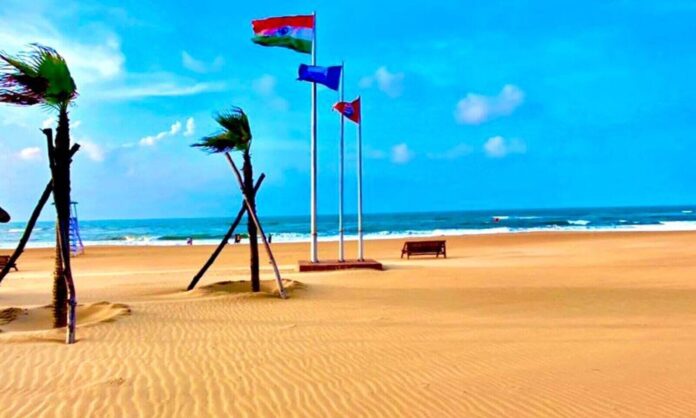Table of Contents
Introduction
India’s coastal beauty is rapidly gaining global recognition, with its Blue Flag beaches in India leading the way. These pristine shores, from Gujarat to Lakshadweep, not only boast crystal-clear waters and stunning landscapes but also embody sustainability and environmental responsibility.Blue Flag status, awarded by the Foundation for Environmental Education (FEE), is a mark of excellence, ensuring top-tier standards for water quality, safety, and eco-conscious tourism. For travelers seeking both beauty and responsibility, India’s Blue Flag beaches offer a perfect escape where nature and tourism coexist harmoniously.
Blue Flag Certification in India: Championing Eco-Friendly Coastal Tourism
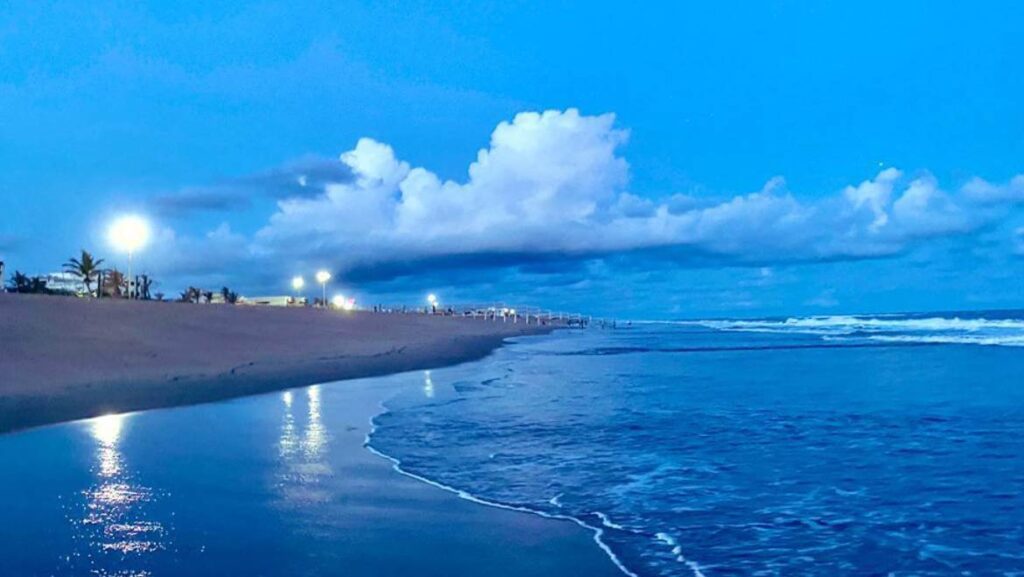
The Blue Flag Certification is a globally recognized eco-label awarded to beaches that meet high standards in environmental management, safety, and sustainability. In India, this prestigious certification is awarded by the Foundation for Environmental Education (FEE). It signifies that a beach is clean, safe, environmentally conscious, and equipped with sustainable tourism infrastructure.
To earn this label, Indian beaches must fulfill strict criteria covering six major areas:
- Water Quality: Regular testing ensures the water is safe and clean for visitors.
- Environmental Education: Informative boards, awareness activities, and local programs promote sustainable coastal practices.
- Safety and Services: Facilities like trained lifeguards, first-aid stations, clean restrooms, and access paths are mandatory.
- Waste Management: Proper systems are in place for garbage disposal, recycling, and keeping the beach litter-free.
- Conservation: Protection of local biodiversity, including plants, animals, and coastal habitats.
- Sustainable Tourism: A focus on minimizing the environmental footprint of tourism while enhancing visitor experiences.
India’s journey with the Blue Flag began in 2020, when it secured its first certified beaches. Since then, the number has steadily increased, with coastal states like Goa, Gujarat, Tamil Nadu, and Lakshadweep embracing this eco-conscious model. These certified beaches now stand as beacons of sustainable tourism, drawing eco-minded travelers from India and across the world.
Top 12 Blue Flag Beaches in India
1. Shivrajpur Beach – Gujarat
Shivrajpur is very important in the form of Gujarat’s first blue flag beach in the middle, which sets a target for permanent coastal tourism in the state. It plays an important role in promoting environmentally conscious journey, maritime conservation and local economic development through responsible tourism. By meeting international standards for hygiene, safety and environmental training, not only improves India’s global tourism image, but also acts as a model to balance natural beauty with stability.
- Dolphin Watching
Experience the thrill of spotting playful dolphins gliding through the waves — best seen during early mornings when the sea is calm and peaceful. - Water Sports Adventure
Dive into the fun with snorkeling, scuba diving, and boating. The clear waters and safe environment make it an ideal spot for first-time adventurers and water lovers. - Visit Dwarkadhish Temple
Enhance your coastal getaway with a cultural detour to Dwarka, one of India’s most sacred pilgrimage cities, located just 20 minutes away.
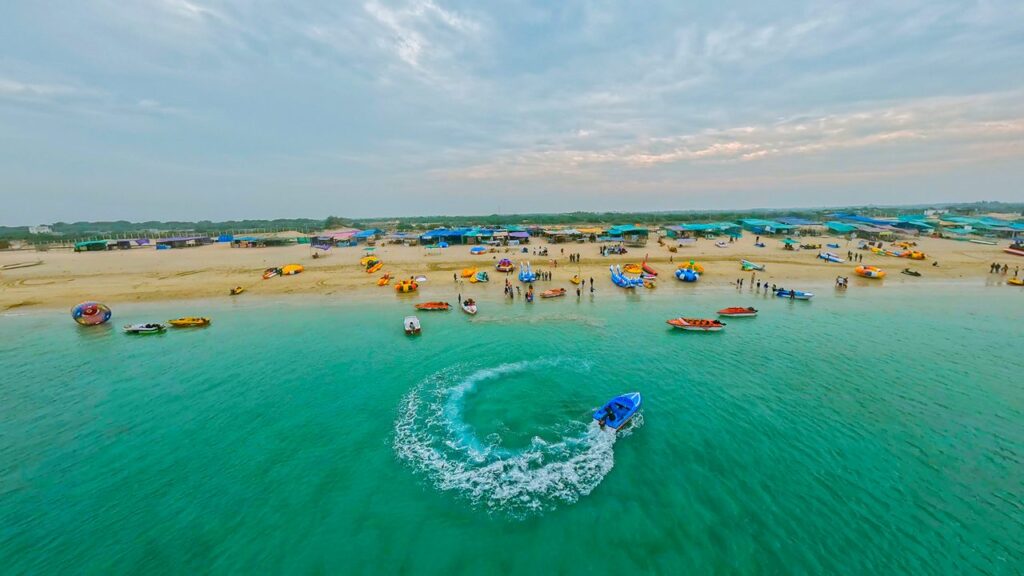
2. Ghoghla Beach – Diu
Located on the northern edge of Diu, Ghaghala Beach is one of the purest and cool coastline in the region. It honors Blue Flag certification and combines environmentally friendly practice with visible attraction. Known to be less crowded, there is a favorite among those looking for a quiet migration, where there is a lot of place for relaxation and entertainment.
- Safe Swimming & Sunbathing
With gentle waves and clear, shallow waters, it’s an ideal spot for safe swimming. Relax on the sand, soak in the sun, and enjoy the laid-back coastal vibe. - Water Sports Fun
Get your adrenaline going with jet skiing, parasailing, and banana boat rides — available through local operators right on the beach. - Catch a Sunset
End your day with a spectacular sunset over the Arabian Sea. The calm atmosphere and golden light make it perfect for photography or quiet reflection.
3. Kasarkod Beach – Karnataka
Kasarkode Beach is a cool, low -composed migration surrounded by green green areas and entertains palm trees. This environmentally friendly beach is honored with the Blue Flag certification, and is perfect for those who want peace, pure environment and a break from the crowd. With minimal commercial development, it provides a raw and peaceful relationship for nature.
- Nature Walks & Bird Watching
Wander through the green surroundings and spot various coastal birds and butterflies in their natural habitat. A paradise for nature lovers and photographers. - Relax & Unwind
Stretch out on the soft sands, listen to the waves, and enjoy the beach’s quiet, uncrowded charm — ideal for meditation or a peaceful read. - Eco Park Exploration
Visit the nearby Kasarkod Eco Beach Park, designed with sustainable elements like solar lights, recycling systems, and educational displays promoting environmental awareness.
4.Padubidri Beach – Karnataka
Located between Udupi and Mangalore, Padubidari Beach is a quiet coastal pearl mixing eco-tourism beautifully with cultural prosperity. Beach is honored with the Blue Flag certification, and is observed for its pure beach, organized facilities and a quiet environment that appeals to both leisure seekers and conscious travelers. The Eco-Park beach, Solar Light and durable design reflect Karnataka’s commitment to green tourism.
- Sunset Strolls Along the Promenade
Enjoy a peaceful walk on the paved promenade, lined with palm trees and offering breathtaking views of the Arabian Sea as the sun dips below the horizon. - Visit the Eco Park
Explore the nearby eco-park with walking trails, native plants, and educational signage — ideal for families and nature enthusiasts. - Experience Local Culture
Time your visit with local festivals or explore nearby temples and coastal villages to get a glimpse into the region’s rich heritage and traditions.
5. Kappad Beach – Kerala
Kappad Beach is not just a scenic destination — it holds tremendous historical significance as the spot where Vasco da Gama first set foot in India in 1498, marking the beginning of European-Indian maritime trade. Today, it beautifully blends cultural heritage with natural serenity, offering visitors a chance to experience Kerala’s rich history alongside tranquil beach vibes. Its Blue Flag certification highlights its commitment to preserving this legacy sustainably.
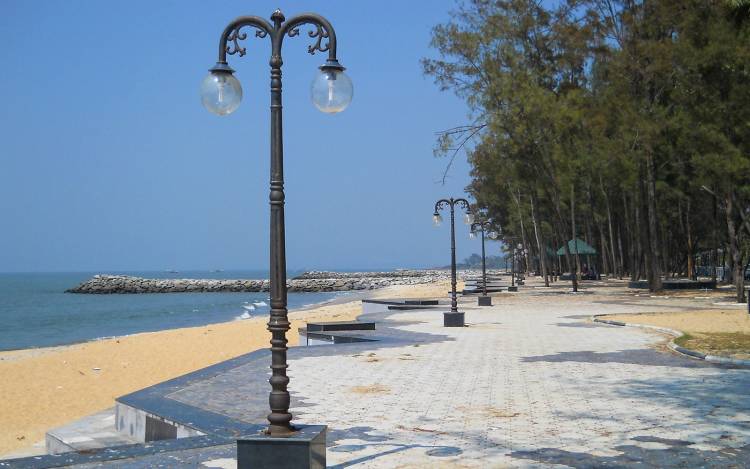
6.Rushikonda Beach – Andhra Pradesh
Rushikonda is a major water sports hub on India’s eastern coastline, making it a magnet for adventure seekers. Nestled between lush green hills and the Bay of Bengal, it offers a rare mix of thrilling activities like jet skiing and parasailing with eco-conscious beach management. The Blue Flag recognition underscores its balance between tourism and environmental care, making it a model for sustainable coastal development in the region.
7. Golden Beach – Odisha
Golden Beach in Puri stands at the intersection of spiritual tourism and sustainable travel. Just steps from the famous Jagannath Temple, it attracts thousands of pilgrims while maintaining world-class cleanliness and safety standards. Its Blue Flag status has transformed it into a symbol of eco-friendly coastal pilgrimage, showing that sacred spaces and environmental stewardship can coexist in harmony.
8. Radhanagar Beach – Andaman & Nicobar Islands
Often hailed as one of the best beaches in Asia, Radhanagar Beach on Havelock Island (Swaraj Dweep) is a tropical paradise known for its powdery white sands, crystal-clear turquoise waters, and lush green surroundings. This Blue Flag certified beach is not just a feast for the eyes but also a model of eco-conscious tourism.
- Environmental Preservation: Radhanagar is a pristine example of how untouched tropical ecosystems can be protected while still being accessible to tourists.
- Biodiversity Hotspot: Its rich marine life and coral reefs highlight the need for conservation and responsible visitor behavior.
- Tourism without Disturbance: The balance between allowing tourism and maintaining ecological harmony makes it a benchmark for future development.
9. Eden Beach – Puducherry
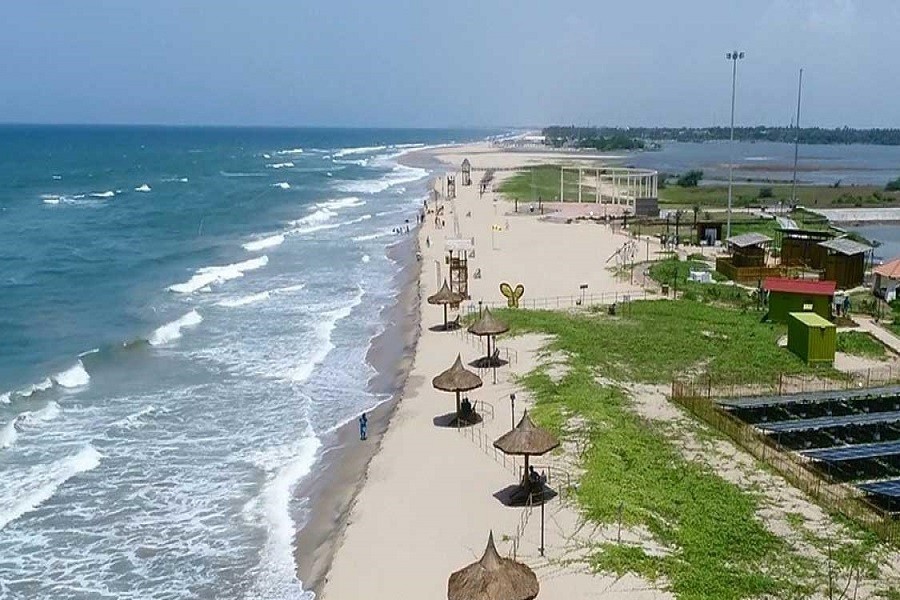
Nestled along the serene coast of Puducherry, Eden Beach is a shining example of how urban beaches can embrace sustainability without losing charm. With its calm waters, golden sands, and well-maintained environment, Eden Beach is one of the few Indian beaches to receive the prestigious Blue Flag certification, symbolizing its high environmental and safety standards.
- Clean and Safe: With top-notch facilities and clean surroundings, Eden Beach shows how urban beaches can maintain high cleanliness and safety standards.
- Family-Friendly Tourism: It supports community-led tourism and provides a peaceful spot for families without overcrowding.
- Waste Management Model: It stands as a model for waste segregation, recycling, and eco-awareness campaigns in coastal towns.
10.Kovalam Beach – Tamil Nadu
Often overshadowed by its namesake in Kerala, Kovalam Beach near Chennai has carved its own identity as a Blue Flag certified destination. With its neat shores, calm waters, and well-planned eco-friendly facilities, this Tamil Nadu gem is fast becoming a benchmark for sustainable beach tourism in South India.
- Eco-Conscious Development: Kovalam Beach boasts solar-powered lighting, well-maintained restrooms, wheelchair accessibility, and proper signage, all built with environmental sustainability in mind.
- Safe and Organized: The beach is secured with trained lifeguards, CCTV surveillance, and designated swimming zones, offering a safe environment for both locals and tourists.
- Educational Initiatives: The beach actively promotes marine conservation awareness and encourages visitors to engage in responsible behavior through interactive boards and eco-campaigns.

11. Minicoy Thundi Beach – Lakshadweep
Located on the stunning Minicoy Island, Thundi Beach is a slice of paradise in the Lakshadweep archipelago, known for its powdery white sand, shallow turquoise lagoons, and thriving coral reefs. As a Blue Flag certified beach, it stands as a testament to India’s dedication to preserving fragile island ecosystems while promoting eco-conscious tourism.
- Marine Biodiversity Hub: The coral reefs around Minicoy are rich in marine life, making it a prime location for underwater exploration and biodiversity conservation.
- Strict Eco-Regulations: Waste disposal, visitor guidelines, and controlled tourist flow ensure the ecosystem remains undisturbed.
- Cultural Preservation: Local traditions and islander hospitality are preserved alongside environmental efforts, promoting cultural eco-tourism.
12. Kadmat Beach – Lakshadweep
A jewel of the Lakshadweep archipelago, Kadmat Beach offers a tranquil retreat with its unspoiled white sands, clear blue waters, and breathtaking coral reefs. Recognized with the prestigious Blue Flag certification, Kadmat Beach is a standout destination for those seeking peace, adventure, and a deeper connection with nature.
- Diver’s Paradise: With world-class visibility and thriving coral gardens, Kadmat is an internationally recognized diving destination.
- Low Footprint Tourism: Its Blue Flag status ensures limited and sustainable tourist activities to protect its fragile environment.
- Model for Island Conservation: Kadmat exemplifies how small islands can balance tourism and environmental integrity through planned development.
The best time to visit : Blue Flag beaches in India is October to March, when the weather is pleasant and ideal for beach activities. Avoid the monsoon season (June to September) due to rough seas and restricted access. Winter months offer clear skies, calm waters, and vibrant marine life.
How to Reach These Beaches : Most Blue Flag beaches are accessible via nearest airports or railway stations in coastal cities like Chennai, Kochi, Goa, and Port Blair. From there, local taxis, ferries, or buses connect you to the specific beach. Advance planning is essential for remote islands like Lakshadweep and Andaman due to limited transport schedules.
Conclusion
Blue Flag beaches in india are more than just scenic escapes — they’re symbols of sustainability, cleanliness, and responsible tourism. Each certified beach offers a unique blend of natural beauty, eco-friendly facilities, and safe, family-friendly environments. Whether you’re a nature lover, an adventure seeker, or simply in need of a peaceful getaway, these beaches promise unforgettable experiences with a purpose — making them a must-visit on your travel bucket list.

